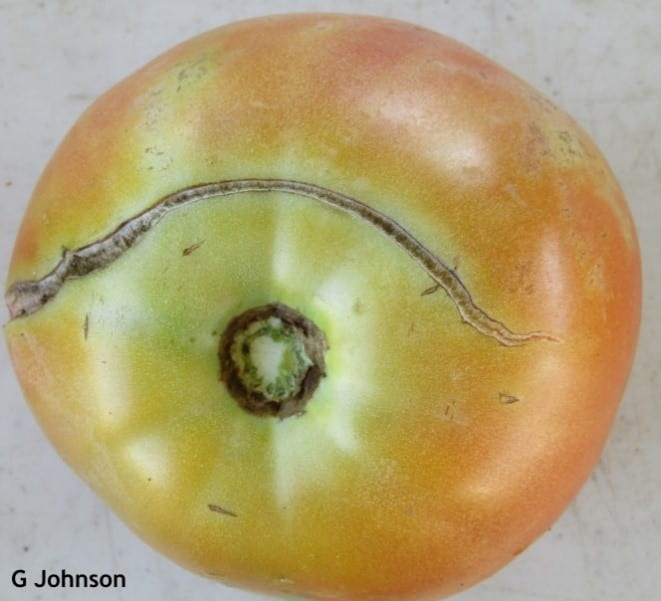Gordon Johnson, Extension Vegetable & Fruit Specialist; gcjohn@udel.edu
Heavy rain during tomato fruit ripening often results in increased fruit cracking in field tomatoes causing extensive losses of marketable fruit.
Cracks in the skin of tomato fruit that expose the internal fruit tissue can appear in several forms.

Radial cracks start at the stem end and extend lengthwise down the fruit. Deep radial cracks render fruit unmarketable and increase the likelihood of fruit rot. In cherry tomatoes the split can go the length of the fruit.

Concentric cracks circle the tomato around the shoulder of the fruit.

Irregular cracks can also appear starting at the fruit shoulder.

Rain checking appears as small cracks arranged concentrically across the shoulders of fruits

In severe cases you can see multiple types of cracking on the same fruit.
Tomato cracking occurs when the skin of the fruit does not expand at the same rate as the fruit interior. Cracking is most common after heavy rain events, but can also occur with irregular irrigation.
Fruit cracking is most prevalent when there is a rapid uptake of water into fruit during ripening when the fruit is accumulating solids. The combined pressure of accumulated water and solutes can split fruits in tomato varieties with low skin elasticity. In addition, during heavy rain events, water can enter the fruit at the stem scar or through minute cracks in the skin shoulder, again causing extra pressure and larger cracks.
Elevated fruit temperatures, often caused by loss of leaf cover, can increase the susceptibility of fruit to cracking as can exposure to high light levels. High humidity around fruit can also increase cracking.
Varieties that are most susceptible to cracking have low skin elasticity during ripening and skin/underlying skin tissue that is thin. Larger fruits tend to be most susceptible; however, many cherry tomatoes are also prone to cracking.
Management of tomato skin cracking starts with selecting crack resistant varieties. Maintain even soil moisture to avoid sudden influx of water into the fruit (but do not over-irrigate). Maintain good fruit cover to keep fruits from overheating and manage fruit load by not over-pruning.
High tunnels and rain shelters are good tools to reduce fruit cracking by controlling plant wetness and soil moisture.
